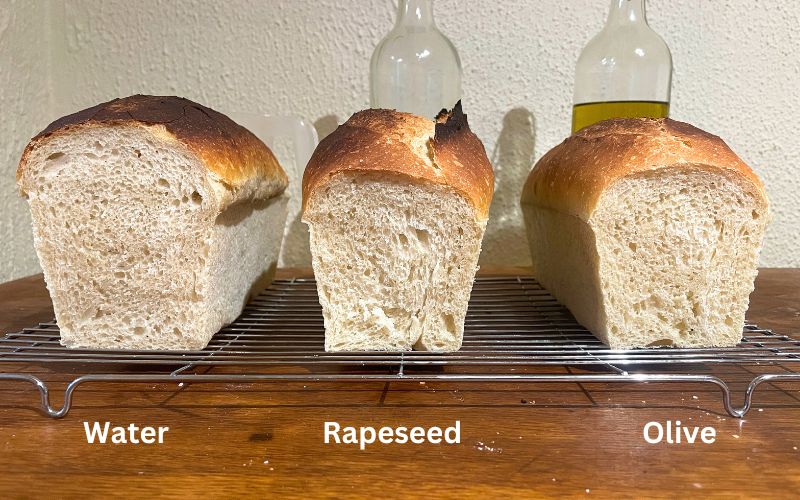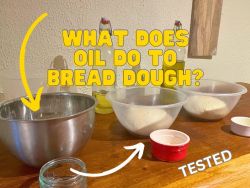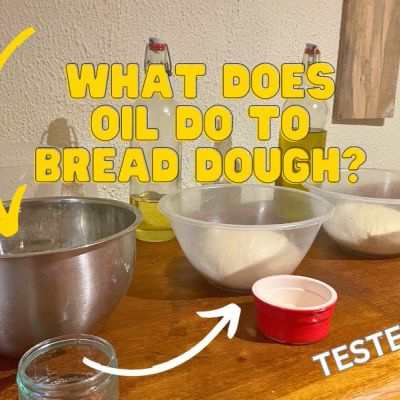If you like to bake your own bread at home, chances are you have come across a recipe containing cooking oil. It’s common to use vegetable, canola and olive oil when baking bread, and you probably know that oil contains fat and many calories, but what does oil do when baking bread?
The short answer is:
Including oil in your bread dough enhances the texture, flavour, and moisture of the bread. Vegetable oil contains many fatty acids and lecithin, making the dough easier to handle and less sticky. Fats make bread softer and extend the shelf-life of bread by staying softer for a longer period.
But there is much more to explore about adding oil to bread, including which oil is best for bread!

Let’s take a look in more detail:
The benefits of adding oil to bread
Following a bread recipe that contains oil or including a type of oil in your favourite recipe provides several benefits.
There are also many recipes that don’t (and should never) require adding oil!!
After reading the following points, you should be able to grasp why you would and wouldn’t want to add oil to bread!
Crumb structure
Oil changes the texture of bread by producing a close-knit gluten structure.
Fatty acids in oils coat the gluten strands, reducing the amount of water the gluten can absorb. Because of the outer barrier, the strands cannot fully stretch out, making the strands shorter and more compact.
The more compact crumb combines with effects we’ll shortly cover to make bread less tearable and chewy. Instead, the texture is soft and aerated.
The shorter-stranded gluten reduces the size of the air pockets in the crumb, producing a regular pocket size.
Texture and moisture retention
When an oil component is added to your bread dough, not only will it improve the crumb structure, but it will also make a softer and moist loaf.
Oil in the dough prevents water from evaporating during baking. So, after baking, the baked bread is moist and soft.
Lecithin, found in some vegetable oils, binds the dough structure together, making a dense yet soft crumb texture.
Fatty acids contained in the oil will also tenderise the gluten, making the texture of the bread soft and fluffy.
Shelf-life extension
The extra moisture in bread dough made with oil makes longer-lasting bread.
The dough retains moisture for longer to appease tastebuds. However, the extra moisture does provide more water activity, which leads to increased microbiological activity and an earlier onset of mould.
The extra acidity of the oil somewhat protects this, yet additional dough improvers can be used to delay mould further.
Lecithin present in oil slows down starch retrogradation, often referred to as bread staling. This is where the starch particles release moisture and recrystallise.
Adding oil to the dough will make the starch molecules more hydrophobic. This means that it will be less likely to absorb excess water.
Without water, enzymes in the dough will have difficulty operating to break down starch molecules. If this process is inhibited, the bread structure will remain unchanged for a more extended period.
Flavour carriers
Oil content acts as a flavour carrier to bread because oil absorbs flavours into its structure. This gives the bread a rich, fuller taste, even when small quantities of oil are used.
Flavour enhancers
Oil also enhances the flavour of bread by browning the bread in the oven. This enhancement is due to Maillard reactions, where sugars and amino acids react when heated.
Malliard reactions intensify the taste of the bread whilst adding caramelised “flavour notes” to perfume the bread’s interior. This is why we often toast bread—aside from making it crispy, browning makes bread taste more flavourful.
Bread with added fats brown faster when baked. Depending on how much oil is used you should consider turning down the heat of your oven midway or at the start of baking.
Delays crust formation
Oil will also delay crust formation in the oven. This benefits the oven spring and means there is little need to add steam to the oven.
A stronger but thinner crust is also produced, which helps the crumb stay fresh by reducing air exposure.
Lubrication
Fatty acids in the oil will lubricate the dough’s gluten strands to prevent them from sticking together.
When laminating dough with layers of fat in bread doughs such as croissants or Danish pastries, adding oil prevents the dough’s layers from sticking together and is easier to roll out.
A better rise and an improved crumb structure are also noted when oil is used in laminated dough. The gluten does not stick together, and your dough will rise up, instead of pushing outwards or down.
Handling
Oil also helps in making the handling of the dough easier for bakers. The dough will not be sticky and, therefore, very manageable.
Its inclusion prevents the dough from deflating prematurely, which increases the oven spring as less energy is required to raise the dough.
Oil is also great as a release agent, so products don’t get stuck, but you probably already knew this!
Comparing lean bread dough with dough using oil
I conducted an experiment to show you how oil changes the texture of the bread first-hand.
Making a batch of dough, I divided it into three. I then returned each dough piece to the bowl separately to incorporate olive oil, vegetable oil or some extra water.
In the first, I added 25 grams of olive oil. In the second, I added 25 grams of rapeseed oil. For the final one, I added 22 grams of water for a fair comparison (oil is around 80% liquid).

Of course, this test had a slight downfall, as there was a waiting period of around 10 minutes between the first and the last doughs being mixed. But this was the most accurate way to conduct the test!
The findings

The base loaf (just water) is pretty light and fluffy. When I push it down with my finger, there is a reasonable amount of bounce, and the taste is pleasant.
The shortening effect of oil in bread was especially noticeable in the rapeseed oil loaf. As I bit into it, the slice snapped into three pieces!
The texture of this bread was even softer and bouncier than the first.
The flavour was delicious and light. However, it was missing something sweet or rich, such as sugar or egg. These additions would make it a really nice treat!
The olive oil bread is less spongy than the rapeseed oil loaf. This is possibly due to olive oil not containing the emulsifier lecithin.
The flavour of this bread wasn’t as enjoyable as the others. Olive oil has quite an intense taste, and after this experiment, I’ve realised that it needs something salty or aromatic to partner it.
What type of oil should I use for bread?

The type of oil you should use depends on what outcome you want your bread to have. There are various types of oils, each with its own purpose. Listed below are some of them:
Olive oil
Olive oil is best for making focaccia or rustic bread because it will give the bread a subtle flavour and a slightly fruity taste.
It does not contain lecithin and, therefore, is not great at enhancing dough structure and shelf life. But it does have plenty of fatty acids, which will tenderise the bread.
Olive oil is perfect for bread with toppings as it does not create a greasy layer on the bread’s exterior.
Vegetable oil
Vegetable oil is a versatile oil that is the most commonly used oil for making baked goods. It is extracted from either of the following plants:
- Canola
- Rapeseed
- Corn
- Sunflower
- Soybean
- Avocado
Yet, it can also be a combination of the above. These types of oil are very versatile and can be applied to different types of baking needs. They are perfect for bread making as they do not have strong tastes and can bring out the flavour of other ingredients. They are also very cost-effective!
Flavoured oil
Flavoured oils such as garlic, walnut, and sesame can also be used to in bread.
These types of oil can provide a nice twist to your regular bread recipes and create different variations.
They all have unique distinct tastes, so it’s nice to experiment with each one to see which one works best for you.
Can I use hard fats instead of oil?
On the other hand, shortening products such as butter and lard are great for making croissants and brioche.
These shortening fats give the end product a very short, buttery flavour.
These products are also often used in making pastry dough as they produce a tender crumb structure.
How much oil should I use in bread dough?
For most types of bread, 2-5% of the total flour should be used. This can increase with enriched bread.
Should I delay the addition of oil?
As the inclusion of oil restricts the length of the gluten strands, at higher usage levels, the gluten structure will be compact.
When adding oil or other fats to a dough where an open crumb is required, it’s best to knead the dough until gluten development reaches its maturity and then add the oil.
This way, the crumb structure can be more open-structured whilst the benefits of texture and flavour of including the fat remain.
Whilst this won’t alleviate the change in structure completely, when adding oil at levels higher than 5%, I always delay its inclusion until near the end of mixing.
Where a close-knit or shorter crumb structure is required, the oil is added at the beginning of kneading.
Conclusion on using oil in bread dough
The type of oil you should use depends on what kind of bread you intend to make. Your choice affects your product’s final taste and appearance. Experiment with different types of oils to see which one fits your recipe.
For the most part, the variety of vegetable oil would usually work well. Let me know your thoughts and experiences with using oil in bread in the comments section below.
Frequently asked questions about oil in bread
If you’ve enjoyed this article and wish to treat me to a coffee, you can by following the link below – Thanks x

Hi, I’m Gareth Busby, a baking coach, senior baker and bread-baking fanatic! My aim is to use science, techniques and 15 years of baking experience to make you a better baker.
Table of Contents
- The benefits of adding oil to bread
- Comparing lean bread dough with dough using oil
- What type of oil should I use for bread?
- Can I use hard fats instead of oil?
- How much oil should I use in bread dough?
- Should I delay the addition of oil?
- Conclusion on using oil in bread dough
- Frequently asked questions about oil in bread
Related Recipes
Related Articles
Latest Articles
Baking Categories
Disclaimer
Address
53 Greystone Avenue
Worthing
West Sussex
BN13 1LR
UK









